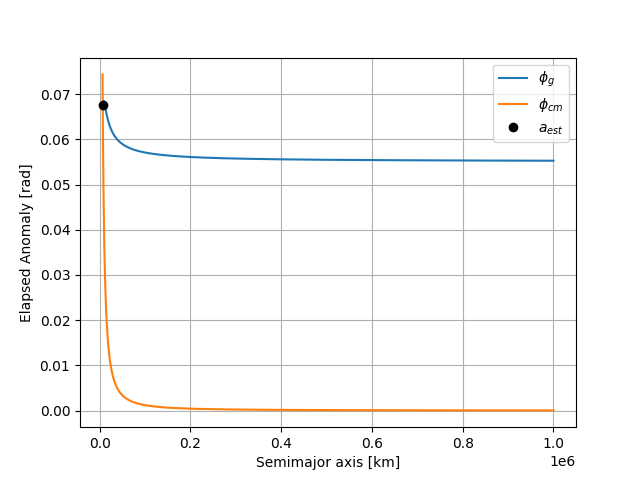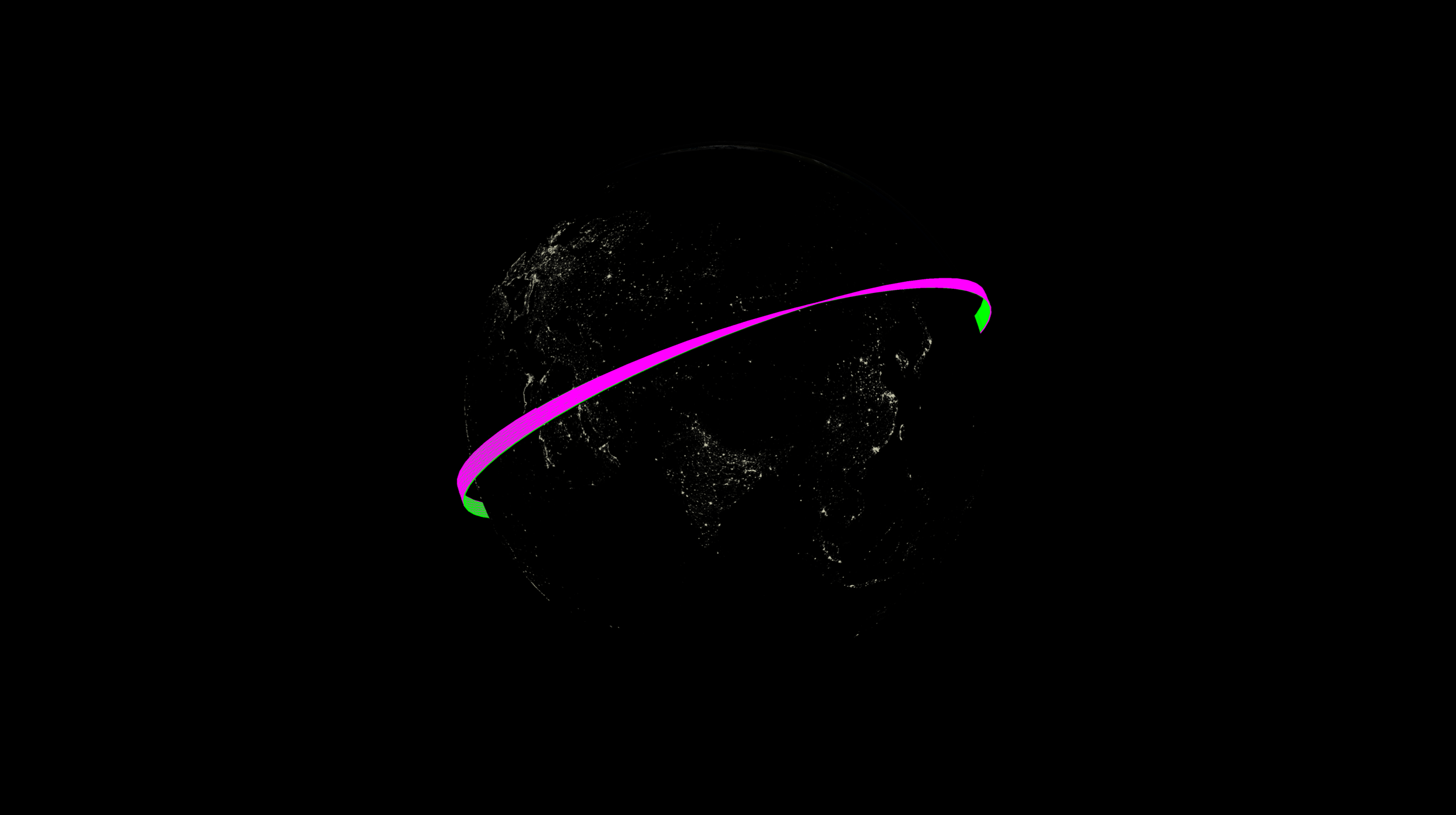Note
Go to the end to download the full example code.
Restricted Circular IOD#
import matplotlib.pyplot as plt
import numpy as np
import pyvista as pv
from scipy.optimize import root_scalar
import mirage as mr
import mirage.vis as mrv
First, let’s define a station and a truth object
station = mr.Station()
obj = mr.SpaceObject('cube.obj', identifier=25544)
Now, let’s create two RA/Dec observations of the object
r_lims = [mr.AstroConstants.earth_r_eq, 1e6]
dates = mr.date_linspace(mr.now(), mr.now() + mr.minutes(1), 2)
r_sat_truth = obj.propagate(dates)
r_station = station.j2000_at_dates(dates)
r_station_to_sat_truth = r_sat_truth - r_station
rho_truth = mr.vecnorm(r_station_to_sat_truth)
line_of_sight_truth = mr.hat(r_station_to_sat_truth)
ra_truth, dec_truth = mr.eci_to_ra_dec(line_of_sight_truth)
print(f'ra_truth = {ra_truth} [rad]')
print(f'dec_truth = {dec_truth} [rad]')
ra_truth = [2.18247321 2.1588651 ] [rad]
dec_truth = [-1.25881232 -1.31355334] [rad]
To check our work, we should be able to go in the opposite direction to recover the same satellite position vector
line_of_sight_backwards = mr.ra_dec_to_eci(ra_truth, dec_truth)
assert np.all(
np.abs(line_of_sight_backwards * rho_truth + r_station - r_sat_truth) < 1e-10
), 'Something went wrong!'
Now, let’s add some noise to our observations
sigma_obs_arcsec = 10.0
sigma_obs_rad = mr.dms_to_rad(0, 0, sigma_obs_arcsec)
ra_obs = ra_truth + np.random.normal(0, sigma_obs_rad, size=ra_truth.shape)
dec_obs = dec_truth + np.random.normal(0, sigma_obs_rad, size=dec_truth.shape)
print(f'ra_obs = {ra_obs} [rad]')
print(f'dec_obs = {dec_obs} [rad]')
ra_obs = [2.18242872 2.15882789] [rad]
dec_obs = [-1.25880856 -1.3134719 ] [rad]
With these observations in hand, we can start to estimate things about the orbit We know that the ranges to the object \(\rho_1\) and \(\rho_2\) are only a function of the semimajor axis \(a\)
lhats = mr.ra_dec_to_eci(ra_obs, dec_obs)
lhat1 = lhats[[0]]
lhat2 = lhats[[1]]
rtopo1 = r_station[[0]]
rtopo2 = r_station[[1]]
rho_1 = lambda a: (
-mr.dot(lhat1, rtopo1)
+ np.sqrt(mr.dot(lhat1, rtopo1) ** 2 + a**2 - mr.vecnorm(rtopo1) ** 2)
).flatten()
rho_2 = lambda a: (
-mr.dot(lhat2, rtopo2)
+ np.sqrt(mr.dot(lhat2, rtopo2) ** 2 + a**2 - mr.vecnorm(rtopo2) ** 2)
).flatten()
r_sat_1 = lambda a: rtopo1 + rho_1(a).reshape(-1, 1) * lhat1
r_sat_2 = lambda a: rtopo2 + rho_2(a).reshape(-1, 1) * lhat2
rhat_sat_1 = lambda a: mr.hat(r_sat_1(a))
rhat_sat_2 = lambda a: mr.hat(r_sat_2(a))
We know that a circular orbit has a constant true anomaly rate, equal to the mean motion \(n = \sqrt{\mu/a^3}\) This means that the angle between the true position vectors of the object at the two observation times is equal to the mean motion times the time between the observations
dt = (dates[1] - dates[0]).total_seconds()
c = mr.AstroConstants.speed_of_light_vacuum
phi_cm = lambda a: np.sqrt(mr.AstroConstants.earth_mu / a**3) * (
dt - rho_2(a) / np.inf + rho_1(a) / np.inf
)
Additionally, the angle between between the position vectors must satisfy the law of cosines
phi_g = lambda a: np.arccos(mr.dot(rhat_sat_1(a), rhat_sat_2(a))).flatten()
For an arbitrary \(a\), the geometry and dynamics of the problem will not produce the same answer! We need to use a root-finding algorithm to find the value of \(a\) that satisfies both equations
sol = root_scalar(lambda a: phi_g(a) - phi_cm(a), bracket=r_lims)
assert sol.converged, 'Something went wrong!'
a_est = sol.root # The estimated semimajor axis in km
print(f'a_est = {a_est} [km]')
a = np.linspace(r_lims[0], r_lims[1], 1000)
plt.plot(a, phi_g(a).flatten(), label=r'$\phi_g$')
plt.plot(a, phi_cm(a).flatten(), label=r'$\phi_{cm}$')
plt.plot(a_est, phi_g(a_est), 'o', color='black', label=r'$a_{est}$')
plt.xlabel('Semimajor axis [km]')
plt.ylabel('Elapsed Anomaly [rad]')
plt.legend()
plt.grid()
plt.show()

a_est = 6804.522813883358 [km]
Now we can find the estimated position vectors at the two observation times
r_sat_1_est = r_sat_1(a_est)
r_sat_2_est = r_sat_2(a_est)
From orbital mechanics, we know that the angular momentum direction is perpendicular to the orbital plane, and that the cross product of the position and velocity vectors is equal to the angular momentum vector
hhat_est = mr.hat(np.cross(r_sat_1_est, r_sat_2_est))
The velocity vector must be perpendicular to the position vector and the angular momentum vector, with magnitude equal to the circular velocity \(v_c = \sqrt{\mu/a}\)
v_c_est = np.sqrt(mr.AstroConstants.earth_mu / a_est)
vhat_est = mr.hat(np.cross(hhat_est, r_sat_1_est))
v_est = v_c_est * vhat_est
print(f'v_est = {v_est} [km/s]')
v_est = [[ 4.07573796 -4.80140163 -4.34898295]] [km/s]
Let’s see how well the estimated orbit matches the measurements
lhat_synth1 = mr.hat(r_sat_1_est - r_station[[0]])
lhat_synth2 = mr.hat(r_sat_2_est - r_station[[1]])
ra_synth1, dec_synth1 = mr.eci_to_ra_dec(lhat_synth1)
ra_synth2, dec_synth2 = mr.eci_to_ra_dec(lhat_synth2)
print(f'ra_error1 = {ra_synth1 - ra_obs[0]} [rad]')
print(f'dec_error1 = {dec_synth1 - dec_obs[0]} [rad]')
print(f'ra_error2 = {ra_synth2 - ra_obs[1]} [rad]')
print(f'dec_error2 = {dec_synth2 - dec_obs[1]} [rad]')
ra_error1 = [0.] [rad]
dec_error1 = [0.] [rad]
ra_error2 = [4.4408921e-16] [rad]
dec_error2 = [0.] [rad]
Plotting the orbits
dates_plot = mr.date_linspace(mr.now(), mr.now() + mr.hours(24), 1000)
rv0 = np.hstack([r_sat_1_est, v_est])
r_est_propagated = mr.integrate_orbit_dynamics(rv0, dates_plot)[:, :3]
r_true_propagated = obj.propagate(dates_plot)
print(
f'maximum position error = {mr.vecnorm(r_est_propagated - r_true_propagated).max()} [km]'
)
pl = pv.Plotter(window_size=(2500, 1400))
mrv.plot3(pl, r_est_propagated, color='magenta', lighting=False, line_width=5)
mrv.plot3(pl, r_true_propagated, color='lime', lighting=False, line_width=5)
mrv.plot_earth(pl, date=mr.now())
pl.show()

maximum position error = 1723.8576928098541 [km]
We could solve for other orbital elements: The inclination of the orbit is the angle between the angular momentum vector and the inertial z-axis
i_est = mr.angle_between_vecs(hhat_est, np.array([0, 0, 1])).squeeze()
print(f'i_est = {i_est} [rad]')
i_est = 0.9003080879195137 [rad]
The cross product of the inertial z-axis with angular momentum vector is the ascending node vector. The right ascension of the ascending node is the angle between the ascending node vector and the inertial x-axis
Omega_hat_est = mr.hat(np.cross(np.array([0, 0, 1]), hhat_est))
Omega_est = mr.angle_between_vecs(Omega_hat_est, np.array([1, 0, 0])).squeeze()
print(f'Omega_est = {Omega_est} [rad]')
Omega_est = 0.2874384404251377 [rad]
The argument of latitude is the angle between the ascending node vector and the position vector at the first observation time
u_est = mr.angle_between_vecs(Omega_hat_est, r_sat_1_est).squeeze()
print(f'u_est = {u_est} [rad]')
u_est = 2.3821470202291364 [rad]
Total running time of the script: (0 minutes 4.086 seconds)
